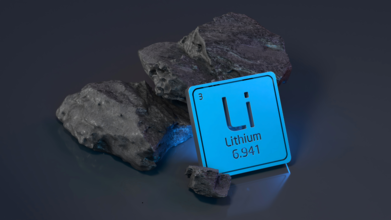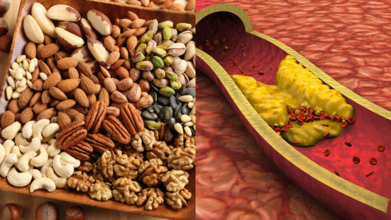- Health Conditions A-Z
- Health & Wellness
- Nutrition
- Fitness
- Health News
- Ayurveda
- Videos
- Medicine A-Z
- Parenting
- Web Stories
Can THIS Naturally Occurring Element Treat Alzheimer's

Credits: Canva
A new study published this week in Nature has found that the loss of lithium, which is a naturally occurring element in the brain. This could be an early warning sign of Alzheimer’s disease and a key driver of its progression. Alzheimer’s affects more than 7 million Americans, and this finding offers fresh hope for treatment strategies.
The research, led by Bruce A. Yankner, a professor of genetics and neurology at Harvard Medical School, shows that lithium plays a vital role in maintaining the health of all major brain cell types in mice. When lithium levels in the brain drop, it appears to contribute to nearly all the major forms of brain deterioration seen in Alzheimer’s disease.
While lithium’s link to Alzheimer’s is new, the metal itself has a long medical history, most notably in mental health treatments.
What Is Lithium?
Lithium is the lightest metal found in nature. Silvery and soft, it’s best known today for powering our smartphones, laptops, and electric vehicles, all thanks to its ability to store large amounts of energy and discharge electrons quickly.
Its use in everyday products has an unusual history.
The original version of the soft drink 7Up contained lithium citrate and was marketed as “Bib-Label Lithiated Lemon-Lime Soda,” reported the Washington Post.
Lithium was removed in 1948 after the U.S. Food and Drug Administration (FDA) banned its inclusion in soft drinks.
Today, Australia leads the world in lithium production, while Bolivia, Chile, and Argentina form the so-called “lithium triangle” due to their rich reserves.
Lithium’s Role in Mental Health
Lithium carbonate, a chemical form of the metal, has been a cornerstone in the treatment of bipolar disorder since its approval by the FDA in 1970. It is considered a mood stabilizer and is sometimes prescribed for long-term depression management.
Although researchers still don’t fully understand how it works, lithium is thought to reduce stress in the brain and boost neuroplasticity, the brain’s ability to adapt and reorganize itself over time.
The new Nature study adds to this understanding, showing that our brains naturally contain small amounts of lithium.
Historically, lithium use in psychiatry dates back to the mid-19th century, but it gained prominence in the late 1940s when Australian psychiatrist John Cade found it helped stabilize bipolar patients.
“It’s been around for decades, and we have a lot of research and evidence supporting its use,” said Elizabeth Hoge to the Post. Hoge is a psychiatry professor at Georgetown University School of Medicine. However, Hoge cautioned that lithium treatment requires regular monitoring of kidney and thyroid function.
ALSO READ: Could Lithium Deficiency In The Brain Trigger Alzheimer’s?
Balwinder Singh, a psychiatry professor at the Mayo Clinic, as reported by the Post, calls lithium the “gold standard” for bipolar disorder, though it is prescribed less often in the U.S. than in Europe. Only about 10–15% of American bipolar patients take lithium, compared with around 35% in Europe. Singh also highlighted its unique benefit: “Lithium is the only mood stabilizer consistently shown to reduce suicidality.”
That said, some research has questioned lithium’s effectiveness for bipolar depression, finding it may not outperform placebos or antidepressants in certain cases.
Why Researchers Are Exploring Lithium for Alzheimer’s
Lithium’s potential role in Alzheimer’s is not entirely new. Past studies have hinted at its protective effects on the brain.
A 2017 Danish study suggested that communities with higher lithium levels in drinking water had lower rates of dementia.
Yankner’s team became interested in lithium after measuring the levels of 30 different metals in the brains and blood of three groups: cognitively healthy individuals, those in the early stages of dementia, and those with advanced Alzheimer’s. Of all the metals tested, only lithium showed a significant difference among the groups.
Lithium appears to help maintain the brain’s “communication network” by supporting neuron connections, producing the myelin that insulates those connections, and aiding microglial cells in clearing cellular debris—processes essential for memory and cognitive health.
How This Could Lead to New Treatments
In lab tests, Yankner’s team administered small amounts of lithium orotate, a different lithium compound, to mice with Alzheimer’s-like symptoms. The treatment reversed the disease model and restored brain function in the animals.
While the results are promising, Yankner stressed that it’s too early for people to start taking lithium for Alzheimer’s. The compound has not yet been tested in humans for this purpose, and lithium can be toxic if improperly dosed.
“This should spur clinical trials,” Yankner said, but he also cautioned that “things can change as you go from mice to humans.”
For now, the research offers an intriguing lead but not an immediate solution. Clinical trials, if launched soon, could take years to confirm whether lithium could safely and effectively slow or prevent Alzheimer’s in people.
A Small Metal With Big Potential
Scientists, now, are beginning to understand that it may also hold a key to protecting the brain from one of the most devastating diseases of our time.
If future studies confirm lithium’s benefits for Alzheimer’s, it could pave the way for a treatment that works by restoring something the brain naturally produces, rather than introducing an entirely foreign substance.
A 4-Step Science-Backed Routine That Works for Every Skin Type

There was a time when skincare felt like a competitive sport. People layered acids, scrubbed their faces raw, and measured success in stings, peels, and redness. But times are changing. A new, science-backed wave is sweeping in, one that values results without leaving your skin feeling like it has been through a survival reality show.
From Shelf Overload to Skincare Simplicity
For years, we’ve been told more is better. More products, more steps, more actives, until our bathroom shelves looked like mini-pharmacies. But skin, much like us, thrives in balance. Aggressive routines may deliver quick wins, but they often come with side effects like irritation, dryness, or breakouts that weren’t invited to the party.The modern approach is a gentler, more measured one: using well-formulated products that are kind to the skin barrier but still pack enough punch to make a visible difference. And the best part? You only need a few steps, not a 12-item shopping list.
The Four Steps That Actually Work
Malini Adapureddy, Founder of Deconstruct Skincare, swears by a routine that’s simple enough to remember before coffee and effective enough to see results in weeks. Designed for Indian skin and climate, this four-step method covers the essentials: cleansing, treating, moisturising, and protecting.
Step 1: The Clean Slate
Every story starts somewhere, and for your skin, that’s cleansing. But the goal isn’t to strip your face like it’s a frying pan that’s just seen a masala spill. A gentle oil-control face wash with salicylic acid and niacinamide is the ticket. Salicylic acid slips into pores to keep them clear, while niacinamide calms and balances.Step 2: The Targeted Glow Shot
Once the canvas is prepped, it’s time for the serum stage. Enter a 10% vitamin C serum with 0.5% ferulic acid. Vitamin C is your radiance best friend, helping to fade pigmentation and even out skin tone, while ferulic acid boosts its stability and antioxidant power. Together, they help defend against environmental stressors and bring your complexion back from the land of dull.Unlike some actives that feel like they’re burning through your soul, this combination is gentle enough for daily use.
Step 3: The Barrier Hug
Moisturiser is often seen as the “optional” step, especially if you have oily skin. But hydration isn’t just about adding water; it’s about locking it in. A lightweight, oil-free moisturiser with natural moisturising factors (NMF) and panthenol keeps your skin barrier happy. It helps reduce sensitivity, supports repair, and works in harmony with your actives. And in India’s hot, humid, sometimes dusty climate, that’s a much-needed shield.Step 4: The Non-Negotiable
Sunscreen. Always sunscreen. Whether you’re outside chasing errands or inside chasing deadlines, UV damage is sneaky. It causes pigmentation, speeds up ageing, and undoes all the hard work your serum and moisturiser put in. A broad-spectrum, gel-based sunscreen keeps things light, non-greasy, and comfortable, even under makeup.Why Gentle Works Better Than You Think
There’s a myth that 'strong' means 'effective'. In reality, harsh products can damage your skin barrier, leaving it inflamed and reactive. Gentle formulations, when done right, work gradually but deeply. They’re like the friend who doesn’t shout advice but still changes your life.Consistency is the secret here. When your skin isn’t constantly fighting irritation, it can focus on repairing itself, building resilience, and looking better over time.
What Is Pulmonary Fibrosis and Why That Annoying Cough Might Be More Than Just a Cold

Credits: Canva
If you’ve been coughing for weeks, blaming it on “lingering winter sniffles” or chalking it up to “just getting older,” it might be time to step away from the cough syrup and lean in for some uncomfortable truth. Your cough could be more than a seasonal annoyance. In rare but serious cases, it could be a red flag for a life-limiting condition called pulmonary fibrosis.
What is Pulmonary Fibrosis?
In plain terms, “pulmonary” means lungs, and “fibrosis” means scarring. It’s a serious, progressive condition where lung tissue becomes scarred and stiff, making it increasingly hard to breathe.
Reportedly, there’s currently no cure. Treatments exist, but they mainly slow down the damage rather than reverse it. The sooner you get diagnosed, the better your chances of managing symptoms and that’s where spotting the signs early is crucial.
Symptoms to Watch For
- Shortness of breath (especially when climbing stairs or speed-walking to catch the bus)
Why That Cough Happens
Coughing is your body’s bouncer, booting out anything that might harm your lungs — dust, smoke, rogue crumbs, the works. The process involves your vocal cords clamping shut, then snapping open with a burst of air.
With pulmonary fibrosis, this reflex can get stuck on a loop. Coughing irritates the vocal cords, which makes you cough more, which irritates them further, a vicious cycle that can turn even a quiet cup of tea into a coughing fit.
The Four Flavours of Cough
- Acute cough – Lasts less than three weeks; often tied to infections or irritants.
Coughs can also be:
- Dry/unproductive – Triggered by things like temperature changes, dusty air, or laughing.
Who’s More at Risk?
While pulmonary fibrosis can happen to anyone, your risk might be higher if you:
- Are over 50
Managing the Cough
A pulmonary fibrosis cough often doesn’t respond to standard cough medicines. Instead, treatment usually focuses on easing symptoms and improving quality of life.
Your doc may recommend alternative medications used for chronic cough in other conditions. These don’t cure the scarring but can make the coughing less intrusive. They’ll also want to check for other contributing factors like acid reflux, sinus issues, or side effects from medication, because if those are making things worse, tackling them can help.
Everyday Coping Tricks
While you work with your doctor, you can try a few lifestyle tweaks to manage coughing fits:
- Avoid smoky, dusty, or heavily polluted spaces
Pulmonary fibrosis is rare, but catching it early can mean more treatment options and better management. Plus, you’ll finally know whether your cough is from a stubborn cold or something that needs closer attention. Your cough could be a harmless side effect of a dusty ceiling fan or it could be your body waving a red flag.
Scientist Reveals the Tiny Foods That Can Transform Your Cholesterol in Just 10 Days

If you’ve ever stared at a packet of mixed nuts wondering whether to sprinkle them over your porridge or just eat them by the handful, here’s your permission slip: go for it. According to Dr Sarah Berry, a professor at King’s College London and Chief Scientist at ZOE, nuts and seeds are not just snackable; they are good for cholesterol crunching. In fact, swap some of your less healthy fats for these nutritional powerhouses, and you could lower your cholesterol by up to 10 per cent in just 10 days. That is faster than most fad diets.
The 10-Day Cholesterol Challenge
High cholesterol often feels like one of those invisible problems, until it suddenly is not. It can quietly build up in your arteries, increasing the risk of heart attacks and strokes. But Dr Berry, during an appearance on the Zoe podcast, said that you can make a real difference in under two weeks by tweaking, not overhauling, your diet. It’s not about eating less fat; it’s about eating the right kind of fat.
And this is where most people get it wrong. “Don’t do a low-fat diet,” Dr Berry warns, calling the idea “radical” to anyone still following decades-old advice. Instead, aim for a moderate-fat diet rich in polyunsaturated and monounsaturated fats—exactly the kinds you’ll find in nuts, seeds, and certain oils.
Why Low-Fat Diets Miss the Point
It is tempting to think cutting fat will cut cholesterol, but Dr Berry explains that’s a trap. Not all fats are bad. Saturated fats, found in red meat and some processed foods, can push LDL cholesterol—often dubbed “bad” cholesterol—into dangerous territory. But polyunsaturated fats, abundant in seeds, seed oils, and many nuts, do the opposite.
Simply adding nuts to your meals, whether as a snack, salad topping, or nut butter, can slash LDL cholesterol by 5 to 10 per cent. You have to make a swap. This benefit comes from replacing “harmful” fats, like those in certain animal products and fried foods, with healthier plant-based fats.
Seeds: The Cholesterol Fighters
Sunflower seeds, flaxseeds, chia seeds—they’re all loaded with polyunsaturated fatty acids that support heart health. Stir them into yoghurt, blend them into smoothies, or scatter them over roasted veggies. You’ll barely notice the extra effort, but your arteries will thank you.
Seed oils, like sunflower and flaxseed oil, can also be smart choices in moderation, adding healthy fats to your cooking without the cholesterol-raising impact of certain animal fats.
Rethinking Dairy, Meat, and Carbs
Dr Berry isn’t out to demonise all animal products. Fermented dairy like yoghurt and cheese gets a surprising green light. These foods, she says, don’t have the cholesterol-raising effect you might expect from their saturated fat content. That’s not permission to live on brie and cheddar, but it is a reason to stop fearing your cheese board.
Red meat, however, is a different story. Packed with saturated fats, it’s a direct contributor to rising cholesterol levels. Swapping steak nights for lentil stews or chickpea curries a couple of times a week could make a noticeable difference to your numbers.
Then there’s the carbohydrate conundrum. The real trouble lies with refined carbs like white bread, white rice, and sugary snacks. These are rapidly processed by your body and can be converted into triglycerides, which worsen cholesterol profiles. But whole grains are firmly in the “good for you” column. Wholegrain bread, brown rice, oats, and quinoa can help improve cholesterol levels when they replace the refined stuff.
Building Your 10-Day Cholesterol Menu
Swap your morning white toast for porridge topped with walnuts and chia seeds. Your mid-morning biscuit could become a small handful of almonds. At lunch, toss sunflower seeds into your salad, and use olive or sunflower oil for dressing. Dinner might feature grilled salmon or chickpeas instead of steak, with a side of quinoa instead of white rice.
Why This Works So Fast
Cholesterol levels can be surprisingly responsive to dietary changes. LDL cholesterol particles are constantly being produced and cleared from your bloodstream. When you replace saturated fats with healthier fats, you improve your body’s ability to remove LDL cholesterol. Combine that with reducing refined carbs and upping your wholegrain intake, and the improvement can be measurable in just days.
Dr Berry’s advice is refreshingly realistic: no calorie counting, no extreme restrictions, just sensible swaps. It’s about building habits you can maintain beyond the initial 10 days, keeping your cholesterol low for the long haul.
Forget the idea that lowering cholesterol means bland food and joyless salads. With nuts, seeds, and the right fats, you can eat deliciously and still give your heart a health boost in record time.
© 2024 Bennett, Coleman & Company Limited

